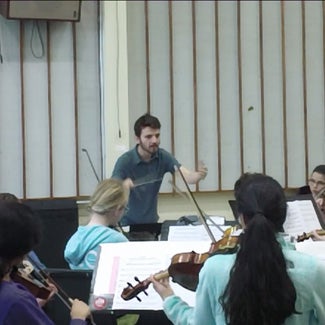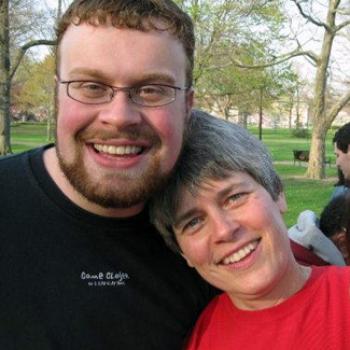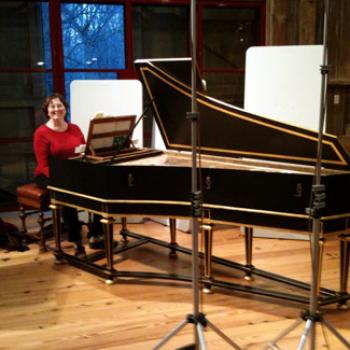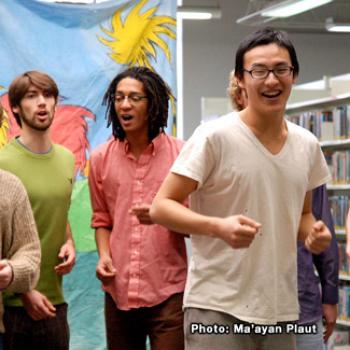On conducting a youth orchestra
Maurice Cohn ’17
“Music is a living art, not to be kept in the glass cases of history museums...I can help foster that kind of energy and excitement about performing in another generation of musicians.”

“Let’s try this one more time,” I said, knowing that I really only had another five minutes or so before losing their attention. “And when we get to the quarter notes at measure 16, remember not to rush!”
It was just after 3:30pm, and the high-ceilinged room I usually associate with conservatory orchestra rehearsals was now filled with hyperactive youngsters who seemed to have momentarily forgotten why they had signed up for this experience. When it’s almost time to go on a Sunday afternoon, holding the attention of a few dozen elementary and middle school music students is a little like convincing my youngest cousin Sam that swimming really will have to wait until after dinner. The next try was better, but we would have to keep working—we only had one more rehearsal before the concert, and measure 16 was still taking off like Sam after some fresh chocolate chip cookies (to be fair, they are a major draw of our annual family reunions). I asked my boss, area music teacher Peggie Willett, what I should be doing, and, as always, she had a solution. In this case, it was several new ways to rehearse the passage, including some altered bowings and selective pizzicato, to make sure everyone in the ensemble was completely confident in the rhythm and not simply following their stand partner. Becoming an effective conductor, I was learning, meant finding the right balance between drilling the details and explaining the concepts.
During the second half of my first year at Oberlin, I took a conducting class with Dr. Joanne Erwin, professor of music education and a specialist in string pedagogy. At the end of the semester, Professor Erwin recommended I apply for an assistant conducting position with the Northern Ohio Youth Orchestras (NOYO). I had a little teaching experience at that point, but the prospect of being at least partially responsible for the growth of so many young musicians was far beyond anything I had done before. More than a bit apprehensive, I put together a résumé, met with Executive and Artistic Director Michael Roest, and, eventually, was given the opportunity to work with NOYO’s younger orchestra, Symphonetta Strings.
I was excited to be given this position which included both a conducting mentorship with Peggie Willett, where I would conduct the whole ensemble, and an opportunity to play my main instrument, the cello, with the students, leading sectionals and small rehearsals. I arrived for my first day assuming that I would be primarily working with the cellists, tuning instruments, and doing all of the small group work that organizations normally hire college students to do. Instead, Ms. Willett greeted me with a cheerful hello and asked, “So, which piece would you like to conduct today?”
In my rush to get to rehearsal early and my certainty that I wouldn’t get podium time until much later on, I hadn’t even brought my baton! I sprinted back to my dorm room to grab it, thankful that I had at least studied all of the music already. Then, after some gloriously unsuccessful attempts to hide my terror, I walked up to the podium to begin the first piece. I knew, intellectually, that when I was in fifth grade, college kids defined cool, but standing in front of the orchestra for the first time I also realized the severe limitations of rational analysis as a calming mechanism. Let no one ever tell you that kids cannot be intimidating.
As the weeks went on, I began to get more comfortable in front of the group. Several weeks later, when Ms. Willett needed to meet with one of the parents, I ran the first part of rehearsal by myself. I started to learn more about individual students—even in an orchestra, music making is still a person-to-person business. Some of them need clear, no frills explanations that don’t take a lot of time, while others only listen if you make them laugh. Some came from schools with a well-developed music program, while for others this group was their only musical outlet. Some of their instruments were a pleasure to play on, and some I had to pry, twist, and push back into working order each week. But each student genuinely loved music.
One week, I was trying to get the violins and cellos to listen more closely to each other, because the melody was alternating between the two parts and they needed to phrase it in the same way. As I was explaining what was required, I suddenly realized that I had just had the same conversation two hours before in a rehearsal with my own string quartet. It became increasingly evident that there were so many parallels between the musical challenges we were facing each Sunday afternoon and the ones waiting for me in my own practice. Sure, the intonation work required from a concerto might be more complicated than what we asked of Symphonetta Strings, but the careful listening skills were the same. Learning to hear, count, and most importantly trust your fellow musicians are skills you never stop working on, and it was a challenge but also a great adventure to try to put these ideas into language the students could understand.
Interning at NOYO reminds me why I fell in love with Oberlin in the first place — the energy, friendliness, and down to earth love of music making that makes being here so exciting. At Oberlin, music is a living art, not to be kept in the glass cases of history museums, and if I can help foster that kind of energy and excitement about performing in another generation of musicians, I’ll consider myself successful — whether or not we rush measure 16. (For the record, they were perfect!)
Tags:
You may also like

On his voice teacher, Kendra Colton ’83
“She taught with a firm, guided, and encouraging hand, but always listened openly to my thoughts and ideas. She allowed me to find my own voice instead of telling me what I should be.”
Jeffrey Hill ’09

In summarizing her many Oberlin memories
“There is so much to do and learn at Oberlin... if you are admitted, choose Oberlin; when there, take as many different courses as you can, meet as many people as possible.”
Karen Gebhart Flint ’64

On singing with the Obertones
“But as I would realize, this love was a postulate of the Obertones; something so obvious it needed no proof through audible declaration. Everyone in the Obertones loves to sing.”
Kevin Hu ’11